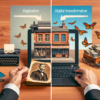Memahami Inovasi Kreatif dalam Era Industri 4.0: Menggabungkan kreativitas dan teknologi untuk menciptakan solusi baru dan meningkatkan efisiensi industri.
Memahami Inovasi Kreatif dalam Era Industri 4.0
-
Table of Contents
- Understanding Creative Innovation in the Era of Industry 4.0
- Introduction
- The Definition of Creative Innovation
- The Importance of Creative Innovation in Industry 4.0
- The Challenges of Creative Innovation in Indonesia
- Successful Examples of Creative Innovation in Indonesia
- The Way Forward: Fostering Creative Innovation in Indonesia
- Conclusion
Understanding Creative Innovation in the Era of Industry 4.0

Introduction
The world is currently experiencing the fourth industrial revolution, commonly known as Industry 4.0. This revolution is characterized by the integration of digital technologies into various industries, leading to significant changes in the way we live and work. One of the key aspects of Industry 4.0 is the emphasis on creative innovation. In this article, we will explore the concept of creative innovation in the context of Indonesia and how it can drive economic growth and development.
The Definition of Creative Innovation
Creative innovation refers to the process of generating and implementing new ideas, products, or services that bring value to individuals, organizations, and society as a whole. It involves combining creativity and innovation to create unique solutions to existing problems or to meet emerging needs. Creative innovation is not limited to any specific industry or sector; it can be applied in various fields, including technology, arts, business, and social sciences.
The Importance of Creative Innovation in Industry 4.0
In the era of Industry 4.0, creative innovation plays a crucial role in driving economic growth and competitiveness. With the rapid advancement of technology, traditional industries are being disrupted, and new opportunities are emerging. Creative innovation enables businesses to adapt to these changes and stay ahead of the competition. It allows companies to develop new products and services, improve operational efficiency, and create unique customer experiences.
Moreover, creative innovation is essential for the development of a knowledge-based economy. In the digital age, knowledge and ideas are the most valuable assets. Countries that foster a culture of creative innovation are more likely to attract investments, create high-value jobs, and achieve sustainable development. Therefore, it is imperative for Indonesia to embrace creative innovation to harness the full potential of Industry 4.0.
The Challenges of Creative Innovation in Indonesia
While creative innovation holds great promise for Indonesia, there are several challenges that need to be addressed. One of the main challenges is the lack of a supportive ecosystem for innovation. Many Indonesian businesses still operate in a traditional manner, with little emphasis on creativity and innovation. There is a need for a shift in mindset and the creation of an environment that encourages experimentation, risk-taking, and collaboration.
Another challenge is the limited access to funding and resources for innovative projects. Many creative individuals and startups struggle to secure the necessary capital to bring their ideas to life. The government and private sector should work together to provide financial support, mentorship programs, and access to networks and markets for aspiring innovators.
Furthermore, there is a need to enhance the education system to foster creativity and innovation from an early age. The current education system in Indonesia is often focused on rote learning and memorization, leaving little room for critical thinking and problem-solving skills. By incorporating creativity and innovation into the curriculum, students will be better prepared for the demands of Industry 4.0.
Successful Examples of Creative Innovation in Indonesia
Despite the challenges, there are several successful examples of creative innovation in Indonesia. One notable example is Gojek, a ride-hailing and on-demand services platform. Gojek revolutionized the transportation industry by providing a convenient and affordable solution for commuting in congested cities. The company’s success can be attributed to its creative approach to solving transportation problems and its ability to adapt to the changing needs of consumers.
Another example is Tokopedia, an e-commerce platform that has transformed the way Indonesians shop online. Tokopedia’s innovative features, such as its user-friendly interface, secure payment system, and extensive product offerings, have made it a preferred choice for millions of online shoppers. The company’s success demonstrates the power of creative innovation in creating disruptive business models.
The Way Forward: Fostering Creative Innovation in Indonesia
To foster creative innovation in Indonesia, a multi-faceted approach is required. Firstly, there needs to be a cultural shift towards embracing creativity and innovation. This can be achieved through awareness campaigns, training programs, and the recognition of creative achievements. The government should also provide incentives and support for businesses and individuals engaged in creative innovation.
Secondly, there should be increased collaboration between the government, private sector, and academia. By working together, these stakeholders can create an ecosystem that nurtures creative talent, provides access to resources, and facilitates knowledge sharing. Public-private partnerships can also play a crucial role in funding innovative projects and scaling up successful initiatives.
Lastly, the education system should be reformed to promote creativity and innovation. This can be done by incorporating project-based learning, critical thinking exercises, and entrepreneurship education into the curriculum. Schools and universities should also establish innovation labs and incubators to provide students with hands-on experience in creative problem-solving.
Conclusion
In conclusion, creative innovation is a vital component of Industry 4.0 and holds immense potential for driving economic growth and development in Indonesia. By embracing creative innovation, businesses can adapt to the changing landscape, create new opportunities, and enhance their competitiveness. However, to fully harness the benefits of creative innovation, Indonesia needs to address the challenges and foster a supportive ecosystem that encourages creativity, collaboration, and risk-taking. With the right strategies and investments, Indonesia can position itself as a leader in creative innovation and reap the rewards of Industry 4.0.







